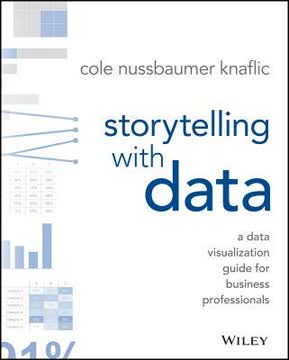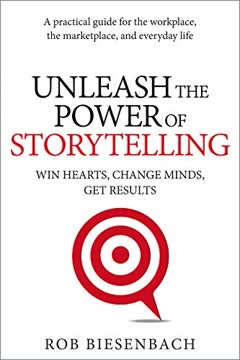Key Takeaways
1. Stories are powerful tools for communication and persuasion
Stories sweep us up and involve us in multiple important ways — physiologically, emotionally, intellectually.
Science behind storytelling. Research shows that stories produce oxytocin in the brain, fostering empathy and cooperation. They stimulate the same areas of the brain as real experiences, making them more memorable and impactful than facts or statistics alone. This neurological response explains why stories are so effective at influencing beliefs and behaviors.
Key elements of powerful stories:
- Tap into emotion
- Put a face on an issue
- Connect us through universal experiences
- Humanize the storyteller
- Raise the stakes
- Show, don't tell
Real-world applications. Stories can be used to:
- Market a business
- Promote a brand
- Close a sale
- Attract investors
- Build trust with employees
- Rally a team
- Win over skeptics
- Nail a job interview
2. Effective stories have a simple structure: character, goal, challenge, resolution
In its simplest form, a story is a character in pursuit of a goal in the face of some challenge or obstacle.
Character. The protagonist should be relatable to your audience. In business storytelling, this could be a customer, employee, or even yourself. Make sure to provide enough detail to make the character feel real and three-dimensional.
Goal. What does the character want to achieve? This should be clear and specific, driving the action of the story forward.
Challenge. Obstacles create conflict and tension, making the story engaging. These could be external (e.g., competition, market conditions) or internal (e.g., self-doubt, lack of skills).
Resolution. How does the character overcome the challenge? The resolution should tie back to your main point or message. It doesn't always have to be a happy ending, but it should provide closure and a lesson learned.
- Example structure: Introduce character → Establish goal → Present challenge → Describe attempts to overcome → Reveal resolution → State lesson or takeaway
3. Emotion is the key driver of storytelling impact
If you want your audience to do something, make them feel something.
The science of emotion. Neuroscience research shows that emotion drives decision-making. When we experience an emotional response, we're more likely to remember information and take action. This is why stories that evoke feeling are more persuasive than dry facts alone.
Techniques for evoking emotion:
- Focus on the "why" behind actions and decisions
- Tap into loyalty, pride, and personal connections
- Celebrate heroes and role models
- Get personal by sharing vulnerabilities and passions
- Use sensory details to make stories vivid
Balancing emotion and professionalism. While emotional storytelling is powerful, it's important to maintain authenticity and avoid manipulation. Use emotion strategically to support your message, not as a replacement for substance. Practice expressing genuine feelings in a controlled manner to strike the right balance.
4. Focus your story by eliminating unnecessary details
Just as important as what goes in to a story is what you leave out.
The power of simplicity. A focused story is more impactful and memorable. By eliminating extraneous details, you allow your core message to shine through. This requires objectivity and a willingness to "kill your darlings" – removing elements you may personally like but that don't serve the story's purpose.
Techniques for focusing your story:
- Start with a clear goal or premise
- Eliminate minor characters and subplots
- Avoid tangents and backstory dumps
- Use clear, concise language
- Simplify dates, numbers, and technical jargon
- Cut exposition and start with action
The "so what?" test. For each element of your story, ask yourself, "So what? How does this serve the main point?" If you can't justify its inclusion, consider removing it. Remember, your audience's time and attention are valuable – respect that by delivering a tight, purposeful narrative.
5. Find and collect stories from various sources in your daily life
To be an effective communicator, you have to be a lifelong collector of stories, so when you really need one, it's right there for you, ready to be shared.
Develop a story filter. Identify your key messages, values, or areas of expertise. Use these as a lens to spot relevant stories in your everyday experiences.
Sources for great stories:
- Personal experiences and observations
- Conversations with colleagues, customers, and friends
- Books, articles, and other media outside your usual field
- Travel and new experiences
- Interviews with interesting people in your network
Create a story bank. Develop a system for capturing and organizing stories you come across. This could be a digital note-taking app, spreadsheet, or physical journal. Tag stories by theme, audience, or purpose for easy retrieval when needed.
Practice storytelling regularly. Look for opportunities to incorporate stories into your daily communication. The more you practice, the more natural and effective your storytelling will become.
6. Use storytelling techniques in presentations for maximum engagement
Stories should be the centerpiece of any presentation, whether you're speaking to a small group around a conference room table or hundreds of people in a ballroom.
Structure your presentation around stories:
- Open with a story to hook the audience
- Use stories to illustrate key points throughout
- Close with a story that ties back to your opening
Delivery techniques:
- Practice your stories to find the right pacing and emphasis
- Use your voice, facial expressions, and body language to bring the story to life
- Stay present and connected to the material, even if you've told it many times
- Vary your vocal expression (volume, speed, tone) for emphasis
- Create "stage pictures" with your movements to illustrate different parts of the story
Balance stories with data. While stories are powerful, they should be supported by facts, statistics, and other evidence. Use stories to make your data more relatable and memorable, not as a replacement for solid information.
7. Craft your personal brand story to stand out professionally
Your brand is essentially what you're known for — the unique combination of qualities you bring to the table that make people want to work or do business with you.
Identify your brand:
- Reflect on your strengths and unique qualities
- Consider feedback from colleagues and performance reviews
- Look for patterns in your successes and challenges
Develop your brand story:
- Structure it like any other story (character, goal, challenge, resolution)
- Focus on how you've overcome obstacles or solved problems
- Highlight what sets you apart from others in your field
- Include your motivations and values
Communicate your brand effectively:
- Tailor your story to different audiences and situations
- Use specific examples and anecdotes to illustrate your qualities
- Strike a balance between confidence and humility
- Ensure your actions and demeanor align with your brand story
Remember, your personal brand is not just what you say about yourself, but how others perceive you. Consistently living your brand story is key to establishing a strong professional reputation.
8. Apply storytelling principles to toasts, tributes, and eulogies
A story can help you frame and focus your thoughts. It may even be easier to deliver. And, of course, stories pack unparalleled power to move people.
Structuring a meaningful tribute:
- Choose 2-3 key qualities to focus on
- Select one story that exemplifies those qualities
- Include sensory details to bring the story to life
- Draw a lesson or impact from the story
Delivery tips:
- Practice to build confidence and manage emotions
- Use notes if needed, but try to maintain eye contact
- Pause and breathe if you become emotional
- Include appropriate humor to lighten the mood
Handling difficult relationships:
- Find one positive quality or memory to focus on
- Acknowledge imperfections without dwelling on them
- Use stories to illustrate complex relationships without explicit judgment
Remember, the goal is to honor the person and connect with your audience. A well-crafted story can achieve this even in emotionally challenging circumstances.
Last updated:
FAQ
What's "Unleash the Power of Storytelling" about?
- Purpose of the book: "Unleash the Power of Storytelling" by Rob Biesenbach is a practical guide to mastering storytelling for business and personal success.
- Content overview: The book covers the essentials of storytelling, advanced techniques, and how to apply storytelling in various contexts like presentations, branding, and personal narratives.
- Target audience: It is aimed at professionals, leaders, and anyone looking to enhance their communication skills through effective storytelling.
- Outcome: Readers will learn to win hearts, change minds, and achieve results by crafting compelling stories.
Why should I read "Unleash the Power of Storytelling"?
- Enhance communication skills: The book provides tools and techniques to improve your storytelling abilities, making you a more effective communicator.
- Practical applications: It offers real-world examples and step-by-step processes for using storytelling in business, presentations, and personal branding.
- Emotional connection: Learn how to tap into the emotional core of stories to engage and persuade your audience.
- Broad applicability: Whether you're in marketing, leadership, or any field that requires communication, the book's lessons are universally applicable.
What are the key takeaways of "Unleash the Power of Storytelling"?
- Story structure: Understand the basic elements of a story—character, goal, and challenge—and how to use them effectively.
- Emotional impact: Emotion is crucial in storytelling; it helps to connect with the audience and drive action.
- Practical techniques: The book provides a five-step process for crafting stories and six ways to ensure they resonate with your audience.
- Application in business: Learn how to use storytelling for branding, presentations, and personal narratives to achieve business goals.
How does Rob Biesenbach define a story in "Unleash the Power of Storytelling"?
- Basic structure: A story is defined as a character in pursuit of a goal in the face of some challenge or obstacle.
- Resolution: The narrative is driven by how the character tries to resolve the challenge, leading to a resolution.
- Essential elements: The three legs of the storytelling stool are character, goal, and challenge, which are crucial for a story's foundation.
- Simplicity and clarity: The book emphasizes a simple structure to make storytelling accessible and effective for everyone.
What is the five-step process for crafting stories in "Unleash the Power of Storytelling"?
- Identify your audience: Understand who you are trying to reach and what they care about.
- Define your goal: Determine what you want your audience to do or feel after hearing your story.
- Discover challenges: Identify the obstacles that stand in the way of achieving your goal.
- Find a relatable character: Choose a character that your audience can connect with emotionally.
- Ensure resolution: Make sure your story has a clear resolution that ties back to your goal.
How does "Unleash the Power of Storytelling" suggest using emotion in storytelling?
- Emotion drives action: Emotion is key to influencing decision-making and prompting action from your audience.
- Show emotion: Demonstrating genuine emotion in your storytelling can provoke empathy and engagement.
- Humanize your message: Emotion helps to humanize you and your message, making it more relatable and impactful.
- Strategic use: Use emotion judiciously to enhance your story without overwhelming your audience.
What are some real-life applications of storytelling according to "Unleash the Power of Storytelling"?
- Business presentations: Use stories to make your presentations more engaging and memorable.
- Branding: Craft a compelling origin story for your company to connect with customers and stakeholders.
- Personal branding: Develop a personal narrative that highlights your unique strengths and experiences.
- Everyday communication: Apply storytelling techniques in everyday interactions to build stronger relationships.
How does "Unleash the Power of Storytelling" address the challenges of storytelling?
- Focus on essentials: The book advises focusing on essential elements and cutting unnecessary details to keep stories engaging.
- Preserve integrity: It emphasizes the importance of maintaining the integrity of your story despite external pressures.
- Avoid common pitfalls: The book discusses common storytelling hazards, such as overcomplicating the narrative or losing authenticity.
- Adaptability: It encourages adapting stories to fit different audiences and contexts while staying true to the core message.
What are the advanced storytelling techniques discussed in "Unleash the Power of Storytelling"?
- Declutter your story: Learn to eliminate unnecessary details and focus on the core message.
- Find great stories: Discover methods for uncovering compelling stories in everyday life and professional settings.
- Use of metaphors and analogies: Enhance your storytelling with figures of speech to clarify and emphasize your points.
- Navigate storytelling hazards: Understand the potential pitfalls of storytelling, such as the "tyranny of the narrative" and blurred lines between fact and fiction.
How can storytelling be applied to personal branding as per "Unleash the Power of Storytelling"?
- Define your brand: Identify the unique qualities and strengths that set you apart in your field.
- Craft a brand story: Use storytelling to communicate your brand in a way that feels natural and authentic.
- Align with behavior: Ensure your actions and communications consistently reflect your brand story.
- Adapt to different contexts: Tailor your brand story for various situations, such as job interviews or networking events.
What are the best quotes from "Unleash the Power of Storytelling" and what do they mean?
- "Emotion fuels stories": This quote highlights the importance of emotion in making stories memorable and impactful.
- "Stories are about 'show, don’t tell'": It emphasizes the power of demonstrating your message through storytelling rather than just stating facts.
- "Most of all, don’t hold back": Encourages readers to be open and generous in their storytelling, allowing their individuality to shine through.
- "A great story can help you win hearts, change minds, get results": Summarizes the transformative power of storytelling in achieving personal and professional goals.
How does "Unleash the Power of Storytelling" suggest using stories in a presentation?
- Start with a story: Begin your presentation with a compelling story to capture your audience's attention.
- Intersperse stories: Weave stories throughout your presentation to maintain engagement and illustrate key points.
- Close with a story: End with a story that reinforces your message and leaves a lasting impression.
- Performance tips: Practice your delivery, stay connected to your material, and use body language to enhance your storytelling.
Review Summary
Reviews indicate Unleash the Power of Storytelling is a concise, practical guide to storytelling basics, particularly for business contexts. Many found it helpful for improving communication skills, though some felt it was too basic or repetitive. Strengths include clear explanations of story elements, emotional impact, and applications in presentations and branding. Criticisms include lack of depth for advanced users and limited examples. Overall, readers appreciated the book's straightforward advice but opinions varied on its value depending on prior storytelling knowledge.
Similar Books










Download PDF
Download EPUB
.epub digital book format is ideal for reading ebooks on phones, tablets, and e-readers.




